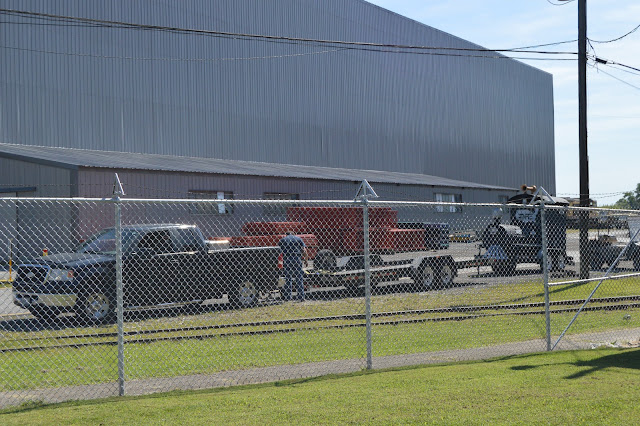 |
| 20150820-21 4187 |
 |
| David Cantrell posted Mt. Vernon (Railroad) Car Manufacturing Company spanned a large section of the town south of the courthouse. The L&N roundhouse and repair shops were purchased by David Settlemeir from Litchfield. The Car Shops opened around August 1890 and operated in Mt. Vernon for 64 years. The L&N had purchased the St. Louis and Southeastern Railway in 1880 and planned to place their repair shops at Howell, IN. National Railway Equipment has buildings to the left today. |
 |
| IRM Strahorn Library posted "Mount Vernon Car Manufacturing Co. Mount Vernon, Illinois" Illinois Railway Museum Strahorn Library Postcard Collection. The Strahorn Library houses thousands of books, tens of thousands of periodicals, and more than a hundred thousand photographs, all centering on the subject of trains and railroading and all held to support research and scholarship into the railroad history of the United States. The Strahorn Library is at 118 E. Washington Street in Marengo, Illinois. It is normally open from 10AM to 2:30PM on Wednesdays, and visitors are welcome. For those unable to visit, we can provide access to our collections via telephone (815-568-1060), e-mail (strahorn@irm.org), or online catalog (librarycat.org/lib/IRMStrahornLibrary). All materials are available for non-commercial purposes and according to the “fair use” provision of the U.S. Copyright Law, which permits the use of copyrighted material for criticism, comment, news reporting, teaching, scholarship, and research. |
 |
| 1941 Aerial Photo from ILHAP |
 |
| John Lewis posted Precision National Plant at Mt Vernon Illinois, June 1981 |
Jason Jordan Funny thing is, this plant was originally owned by American Locomotive Company (A L Co) many years ago.
 |
| 1 |
 |
| 2 |
 |
| 3 |
 |
| 4 |


Rackaway Street crossing EVWR/L&N looking West. (EVWR = Evansville & Western) The diamond is with UP/C&EI.

Looking East along the EVWR. Lots of ballast and the pile of ties in the lower-left corner indicates this shortline is maintaining their track.

Looking West along the EVWR.

#9950 would be the loco we saw hiding above. The other one is #2571.


The photo below is Liberty Street crossing, looking North. The yellow locomotive was a standard cab. It looks like #2571 might have also been a standard cab. Note that one track has two derails on it. They really don't want locomotives to roll past that point.
It looks like they don't mind having tracks in the grass, but they don't want to have them in the weeds.

They shrink wrap the engines, but not the power assembly parts setting on the ground in front of them.

I'm glad I now have a lens that I can put on manual focus and set to infinity so that I can shoot things behind a chain link fence. That day must have been sunny enough that the f-stop was high enough for a good depth of field so that both the fence and parts are in focus.

In the middle of the buildings are some big ducts and "tanks." Is that air treatment equipment for a paint booth?

Looking through the gate by Perkins Avenue. The old BNSF is #2174.

A cute little "parade locomotive" is being put on a trailer.

With the three exhaust pipes, this locomotive is a genset.

I had to get that statue.
This old BNSF is #2188. So we lost some more BNSF locomotives in their BN livery.

Their main engine storage yard is on the north side.

 |
| Satellite |
 |
| Jim Pearson Photography posted The Progress Rail backyard at Mount Vernon, IL On July 23, 201 we find old KORAL Switcher 2111 in the backyard of National Railway Equipment shops in Mount Vernon, Illinois along with a variety of newly rebuilt and old locomotives that are used for spare parts and the like. Switcher 2111 is used to move equipment around. Although it’s seen better days, it still does its job! According to Wikipedia: “The Korea Railroad Corporation, branded as KORAIL, is the national railway operator in South Korea. Currently, KORAIL is a public corporation, managed by Ministry of Land, Infrastructure and Transportation. KORAIL operates intercity/regional, commuter/metro and freight trains throughout South Korea, and has its headquarters in Daejeon. Historically, the South Korean railway network was managed by the Railroad Administration Bureau of the Ministry of Transportation before 1963. On 1 September 1963, the bureau became an agency that was known as Korean National Railroad (KNR) in English. In the early 2000s, split and public corporatization of KNR was decided by the South Korean government, and in 2003, KNR adopted the current KORAIL logo in blue to prepare corporatization. On 1 January 2005, KNR was split into Korea Railroad Corporation (KORAIL), which succeeded railway operation with the KORAIL logo and name, and Korea Rail Network Authority (KR), which succeeded maintaining tracks.” Tech Info: DJI Mavic Air 2 Drone, RAW, 4.5mm (24mm equivalent lens) f/2.8, 1/200, ISO 100. Roger Riblett shared |

















Nice post. GNB Network Power stationary batteries are used as emergency backup power for many railway applications. To learn how the following products can meet your railway or stationary equipment power needs contact our Sales Department by calling 866-324-4410.
ReplyDelete